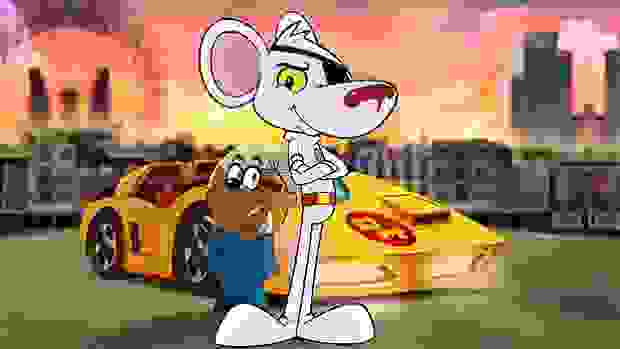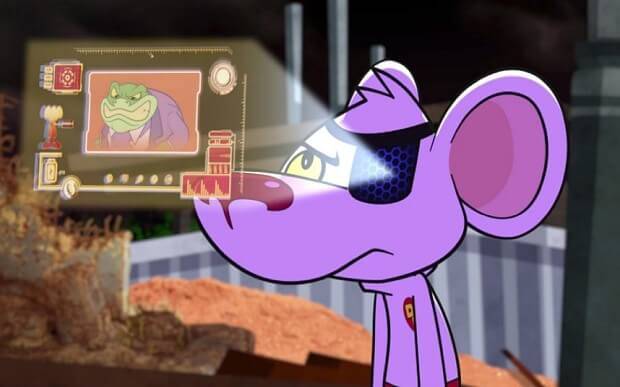Directing Danger Mouse: An interview with Robert Cullen Part Two
Just over a week after Danger Mouse has returned to the big screen and the series has proved to be a critical success appraised for it’s humour that is accessible to both adults and children alike (in spite of airing on a designated children’s channel) with The Telegraph calling it a “snappy British triumph” and a plethora of articles and tweets signifying a universally appreciative audience. Only the Daily Mail seems to disagree giving it 2 stars out of 5 in a tremendously ill informed article that serves as an excuse only to show a picture of Denise Van Outen, but hey – if you’ve annoyed the Mail you know you’re doing something right.
In part one of our interview we spoke to the man who put the movement into Danger Mouse, Robert Cullen. As creative director of Boulder Media Robert leads the team responsible for the look of the show in both style and animation, taking their lead from the gag packed scripts the writers provide.
As the new Danger Mouse continues to be a runaway success we start our chat by asking about the past and if the old Cosgrove Hall team had more than just an influence on the show as the baton was passed over.
Did you have any involvement with the old Cosgrove Hall team was there much communication?
We met Brain Cosgrove and Brian Trueman early on, and we got there blessings on how they were looking, it was great because Brian Cosgrove brought all the model sheets and turn arounds from the original series of the characters and the Danger Car, it was great to see the original artwork and production as well.
How does communication work with the rest of the team such as the writers?
It’s quite a collaborative experience from the start, Ben and his team of writers and Andrew Burrell (producer) who works at the BBC would pitch one page synopsis for an episode and the ones that stand out are developed into a two page synopsis at which point everyone has an input, I had an input with regards to how to make an action scene bigger, but also flag anywhere the script may be too ambitious, for example one script could say “An army of 100 Robots come over the horizon” so I’d say “okay we can’t do that in production” but then figure out how can we do that in a more sensible way but still make it look just as cool. The whole thing is very organic, when we got the whole team together we couldn’t believe how natural it all felt, it seemed to come easy.
The series has a lot more action than I remember. Head writer Ben Ward said he wrote the show how he remembered it rather than meticulously looking back at how it was written, did you animate how remember it?
We knew from the start it was going to be a heavy action show anyway to make it appeal to a new audience and we were ripping on the Bond movies and the Marvel movies where there are BIG action sequences which I think audiences expect, so we went to town with the action scenes.
You’ve managed to incorporate the photographic collage in there too from the old series, which is a good fit.
When we did the original pitch we went back to look at the original series and that was a big part of the original series, they’d always start “LONDON!” and there would be a photograph of London mixed with painted backgrounds as well, it was something that we really wanted to do. With this one we wanted to blur the lines with what is real and what is painted to blur the lines between the two and hopefully get us the cinematic feel we were after.
One of the main things we wanted also was to make the characters feel like they were in a 3D environment or on a set, so all of the characters are lit by the same light to make it a bit more believable.

The writers treat you with scenes on a daily basis are there any particular sequences you look on as achievements for you and the team?
There’s one scene in Planet of the Toilets the whole thing is set in Tokyo, and there is a fight sequence on the roof of a bullet train which is Danger Mouse versus a toilet so the first thing that came into our heads was “this has to be night time” to get the neon lights, we wanted to make it like the Wolverine fight sequences also Mission Impossible, to give it the senese of speed this was one of the first action scenes we looked into and we knew we wanted to make it as real as possible with shakey hand held camera work, lights flying past and really in your face camera effects and music, so yeah that was the first time we went to town on it, we’ve done lots like that since, we have a huge under water battle sequence as well, every episode has something completely different and each one comes with its own challenges, all of the action scenes are grand in scale, we wanted to do something big but also within the schedule.
You’re never bored then with what comes through in the script?
Each episode is different from the last, we might get a horror genre or a fantasy genre or sci fi, episodes might even take place on different planets, so yeah it keeps us on our toes!
What software was used to make series?
Originally we were going to use Flash, every show up until now we used Flash, we started the character designs and turnarounds in Flash, we had done all the mouth shapes and were quite far down the road when we decided that we neede to move over to Toon Boom to achieve the animation that we wanted and get the fluidity so the poor rigger had to redo all of his work! The poor rigger! I think it has paid off though because we have CG in the show, particularly the Danger Car allows us to mix the two. It worked out well in the end but the poor rigger guy nearly had a heart attack!
Danger Mouse continues to thwart evil on the CBBC channel. Listen to the full interview with Robert Cullen and the rest of the team behind the series in the Skwigly Podcast below.


